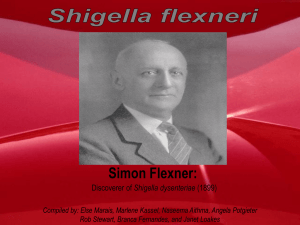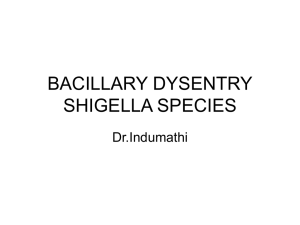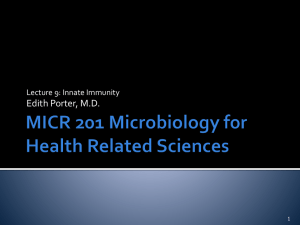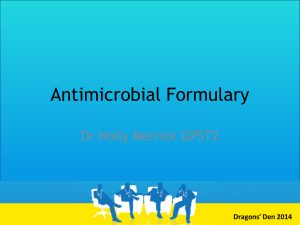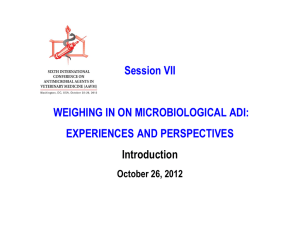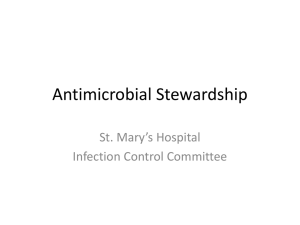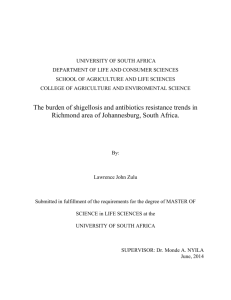S flexneri
advertisement
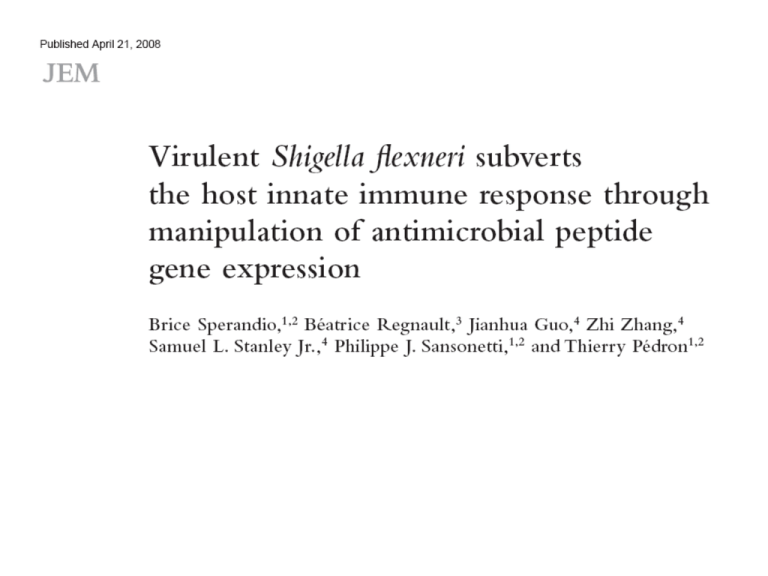
Background information • Antimicrobial peptides • Intestinal epithelial cells regulate immune-cell function • Virulence plasmid is essential forShigella pathogenesis • Pathogenesis of Shigella Antimicrobial peptides (AMPs) • also called host defense peptides • small peptides with broad spectrum antimicrobial activity against bacteria, fungi, viruses • ubiquitously expressed by epithelial cells throughout the GI tract • usually positively charged (cationic peptides) • play an important role in controlling the resident and transient bacterial populations E.g. of AMPs Defensins Cathelicidin Histatins Cathepsin G Azurocidin Latoferrin Antimicrobial peptides (AMPs) • Human defensins α- defensins (neutrophil granules) β- defensins (HBD1, HBD2, HBD3, HBD4) SP – Signal peptide Intestinal epithelial cells regulate immune-cell function • physical barrier • immune barrier Glycocalyx - polysaccharides that projects from cell surface Defensin – a host defense peptide with antimicrobial activity Virulence plasmid is essential forShigella pathogenesis • Invasion plasmid antigens (Ipa ) • Membrane expression of Ipas (Mxi) TTSS • Surface presentation of invasion plasmid antigens (Spa) • Intracellular spread (IcsA or VirG) • Type III Secretory System - TTSS (encoded by Mxi and Spa) Shigella Pathogenesis of Shigella Synopsis In vitro studies – • Human intestinal cell lines were infected with Shigella flexneri • Observed suppression of transcription of genes mainly coding for antimicrobial peptides, like β-defensin (e.g., hBD-3), in these cell lines • MxiE (bacterial regulator) is responsible for such regulatory process In vivo studies – • Human intestinal xenotransplants were used as model, infected with S.flexneri • Confirmed = MxiE dependent system that allows Shigella to suppress expression of antimicrobial peptides • This helps Shigella to progress deeper into intestinal crypts, thereby causing the disease • Down-regulation of additional innate immunity genes (e.g., CCL20) leading to compromised recruitment of DCs at infected area Targeted survival strategy used by Shigella to survive in the host by weakening the host immune system and thus surviving in the intestine Experimental Details Different strains of Shigella • invasive wild-type strain M90T (virulent factors and TTSS system loaded) • invasive mxiE mutant (impaired for the MxiE transcriptional activator regulating expression of several virulence plasmid-encoded effectors, e.g., Osp and IpaH, but TTSS functioning) • non-invasive mxiD mutant (impaired for the MxiD protein, a component of the TTSS required for its functionality ) • non-invasive plasmid-cured BS176 strain Antimicrobial factors gene expression • ß defencins – HBD1, HBD2, HBD3 • cathelicidin – LL37 • CCL20 and its receptor CCR6 TC7 and HT29 colonic epithelial cell lines, Human intersinal xenografts in SCID mice Results – Figure 1 (A and B) Virulent S. flexneri modulates expression of specific innate immune genes in vitro M90T BS176 mxiD mxiE Results – Figure 1 (C and D) Virulent S. flexneri modulates expression of specific innate immune genes in vitro S. flexneri is unable to significantly invade polarized and differentiated TC7and HT29 epithelial cells Gentamicin assay Lactate de-hydrogenase assay TC7 HT29 M90T was unable to significantly invade cells MOI = multiplicity of infection (100) Cellular viability is same Conclusion – Figure 1 (A to D) • wt S. flexneri impairs the expression of specific innate immunity genes by injecting virulent factors into epithelial cells through its TTSS, thereby affecting the host immune system • MxiE dependent effectors are responsible for the observed manipulation of the host immune response through transcriptional damping S. Flexneri >>>>> host innate immune parameter (e.g. defensins) >>>>> role of bacteria’s MxiE and TTSS Results – Figure 2 Virulent S. flexneri modulates expression of specific innate immune genes in vitro TC7 cells stimulated by IL-1ß Uninfected M90T BS176 mxiD mxiE Conclusion - S. flexneri manipulates the host innate immune response through injection of the Mxi-E dependent effectors even in the cells already expressing an inflammatory pattern Results – Figure 3 (A) Antimicrobial factors whose transcription is repressed by S. flexneri are those affecting the highest bactericidal activity against the pathogen Experimental read out = DiBAC fluorescent molecule binds to depolarized membranes during bactericidal activity TC7 M90T BS176 mxiD mxiE DiBAC = bis-(1,3-dibutylbarbituric acid)-tetramethylene oxonol fluorescent molecule Results – Figure 3 (B) Antimicrobial factors whose transcription is repressed by S. flexneri are those affecting the highest bactericidal activity against the pathogen Experimental read out = DiBAC fluorescent molecule binds to depolarized membranes during bactericidal activity Listeria monocytogenes and L. innocua as control for experimental conditions TC7 L. Monocytogeneses L. innocua Conclusions – Figure 3 (A and B) Among the antimicrobial molecules tested in vitro, hBD-3 is the most active antimicrobial factor for S. flexneri From previous results - S. flexneri represses the transcription expression of HBD-3 gene Results – Figure 4 (A) S. flexneri regulates expression of innate immunity genes in vivo • Used human intestinal xenografts in SCID mice – chimerical structure, combining essentially human intestinal epithelium and mouse vascular and immune cells • Essential tool for studying gene expression in human epithelial cells • Focused on genes encoding chemokines, cytokines, and antimicrobial peptides Results – Figure 4 (A) Total 46 genes whose expression was significantly modulated by S. flexneri Of which 11 genes were less transcribed upon infection with M90T compared to mxiE or other strains CCL3, CCL4, CCL20, CCL25, CCR12 – Mainly produced by EC, are involved in recruitment and activation of inflammatory and immune effector cells, like – monocytes, DCs, T cells IL-7, IL-18, IL-13RA1, IL-20RA -Lymphocytes, IFN-γ SOCS 3 (suppressor of cytokine signaling) – upregulated in M90T >>>>> involvement of Jak-Stat pathway in suppressing HBD1 and HBD3 Results – Figure 4 (B) S. flexneri regulates expression of innate immunity genes in vivo Xenografts M90T BS176 mxiE Conclusions – Figure 4 (A and B) In vivo results show that S. flexneri is able to manipulate the host innate response through MxiE-dependent effectors by up- or down-regulating expression of crucial innate immunity genes Results – Figure 5 (A-F) S. flexneri blocks antimicrobial factors expression in vivo Immuno-histochemistry on infected human intestinal xenografts using antisera to hBD1, hBD3, and CCL20 hBD1 hBD3 CCL20 M90T Weak labeling Weak production mxiE Massive luminal release Strong production Results – Figure S1 (A-F) – supplementary material S. flexneri blocks antimicrobial factors expression in vivo hBD1 hBD3 CCL20 uninfected mxiD Massive luminal release Strong production Conclusions – Figure 5 (A-F) hBD1 M90T mxiE hBD3 hBD1 CCL20 hBD3 CCL20 uninfected mxiD Mxi-E dependent S flexneri effectors affect the production of hBD-1, hBD-3 and CCL20 molecules exhibiting antimicrobial activities, thereby weakening the antimicrobial defense barrier at infected mucosal surfaces Results – Figure 6 (A-C) Blocking of antimicrobial factor expression correlates with deeper progression of S. flexneri towards intestinal crypts Bacterial counts in infected human intestinal xenografts using polyclonal antibody to S. flexneri 5a LPS - Qualitative analysis M90T Diffusely distributed in the mucus layer from the top of the villi to the crypts mxiE mxiD Localized to the top of villi, trapped in luminal mucus Results – Figure 6 (D) Blocking of antimicrobial factor expression correlates with deeper progression of S. flexneri towards intestinal crypts Bacterial counts in infected human intestinal xenografts using polyclonal antibody to S. flexneri 5a LPS - Quantitative analysis M90T mxiE mxiD Conclusions – Figure 6 (A-D) Correlates the ability of S. flexneri to block antimicrobial factors expression, and there capacity to progress deeply in intestinal crypts, at the early time point of infection Results – Figure 7 (A-D) S. flexneri compromises recruitment of DCs to the lamina propria of infected tissues Immuno-histochemistry of infected intestinal xenografts by monoclonal biotinylated antibody to mouse CD11c M90T Restricted presence of DCs in submucosa And lamina propria mxiE mxiD Massive recruitment of DCs into the lamina propria and submucosal region uninfected Conclusions – Figure 7 (A-D) Existence of a dedicated MxiE-dependent system allowing S. flexneri to suppress expression of immune effectors, leading to compromised recruitment of DCs to lamina propria of infected tissues. Synopsis In vitro studies – • Human intestinal cell lines were infected with Shigella flexneri • Observed suppression of transcription of genes mainly coding for antimicrobial peptides, like β-defensin (e.g., hBD-3), in these cell lines • MxiE (bacterial regulator) is responsible for such regulatory process In vivo studies – • Human intestinal xenotransplants were used as model, infected with S.flexneri • Confirmed = MxiE dependent system that allows Shigella to suppress expression of antimicrobial peptides • This helps Shigella to progress deeper into intestinal crypts, thereby causing the disease • Down-regulation of additional innate immunity genes (e.g., CCL20) leading to compromised recruitment of DCs at infected area Thanks for your attention !!! Shigella • gram negative bacteria belongs to family Enterobacteriaceae • non-motile, rod shaped • causes disease called Shigellosis – bacillary dycentry (bloody diarrhea) • 4 species of Shigella – S. boydii, S. dycenteriae, S. flexneri, S. sonnei • can be treated by antibiotics • transmission via fecal-oral route • a very small inoculum (only 10-200 organisms) is sufficient to cause infection Infectious pathway for shigellosis Activities of Shigella type III secretion system (T3SS) effectors Klotman et al. Nature Reviews Immunology 6, 447–456 (June 2006) | doi:10.1038/nri1860 Klotman et al. Nature Reviews Immunology 6, 447–456 (June 2006) | doi:10.1038/nri1860 Klotman et al. Nature Reviews Immunology 6, 447–456 (June 2006) | doi:10.1038/nri1860 A simplified model of membrane-ruffle production in response to the stimulation of host cellular signalling by Shigella effectors. Shigella movement within the host-cell cytoplasm requires actin polymerization and microtubule degradation. Shigella and the downregulation of the host inflammatory response.
